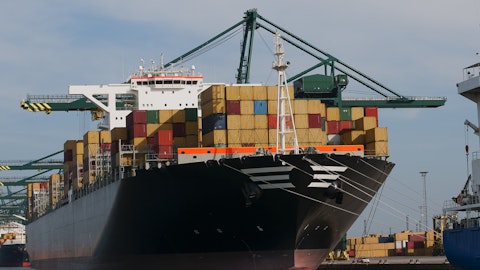Christopher Robertson: Sure. Yes. But it sounds like a pretty compelling inflection point for the company over the next few quarters here. So I think it is definitely an important point.
Robert Bugbee: It is. But what Chris is telling you is that you’re looking at — I’m looking — what I’m saying is an end position once it’s finished. And then the math is real simple, right? You’ve got — you were taking $1.3 billion worth of debt and you’re chopping that down to 500. And I was — what I said was the combination between the principal and the interest. And at the same time, you are you’re knocking out debt that is much more than what debt is coming in at — so you have 2 things working. So I don’t really — he’ll be able to give proper even better cuts coming down to January but you can just take the number and just produce the actual principal by the halves and it’s not too hard to get to that approximate figure that I’m giving at the end of the process.
But the most important thing is not the accuracy of it because that’s sometime in the future. No way you can create a model for this quarter or the start of next quarter because I gave so many caveats to how we get to that level at around 800, 900 by the end of March next year. But you’re going to significantly drop your daily dollars per day breakeven because your debt is quite significant at the moment and interest rates are very high with the legacy leases as well.
Christopher Robertson: Yes, it makes a lot of sense. I guess final question for me, just turning back, sorry to belabor the point on the older ships here. But I mean, it just sounds like it’s really going to have more of an impact on the dirty trade on the crude fleet more than anything. But just to drill down a little bit more. Is there anything that…
Robert Bugbee: Wait, wait, wait, wait… That’s just the way that James framed his slide about the ships turning 20. You could also frame a slide that talks about chips turning 15 years old over the next months, years too…
Christopher Robertson: Sure. And that goes to my question, Robert. Is there anything owners can do today or at least with the cash available that they have today at these rates that they can better maintain ships past that traditional 15 years of age? Or has technology not really changed or the landscape not really changed too much and it’s kind of like that’s still a good hard and fast rule to look at. I’d leave that to Rob…
Chris Abella: Rob, do you want to take that.
Robert Bugbee: Yes, please. Yes, please. Yes. So just simplistically, a vessel is a steel box girder subjected to corrosion and fatigue. And the customers, our clients, the oil majors don’t count the dollars they spend on a time charter or a particular spot fixture, they count the liability in the case of an existential event like the Erica or the Exxon Valdez. And this type of enterprise risk has established an enormous structure around vetting and compliance within our customers. And there is very little that an owner can do to pre-emptively strengthen the steel or protect the steel from that type of wear and tear. The technology around coatings, around surveys, around intermediate surveys, all of that is advancing but it doesn’t do a material or make a material difference to the overall life expectancy of a vessel, particularly given the type of conditions of vessel, basis and service.
Christopher Robertson: Okay. Yes, that’s really helpful. I’ll turn it over.
Operator: This concludes the question-and-answer session. I would like to turn the conference back over to Emanuele Lauro for any closing remarks.
Emanuele Lauro: Thank you, operator. We do not have any closing remarks, apart from thanking everybody for your time today and looking forward to speaking with you all soon. Have a good day.
Operator: The conference has now concluded. Thank you for attending today’s presentation. You may now disconnect.
Follow Scorpio Tankers Inc (NYSE:STNG)
Follow Scorpio Tankers Inc (NYSE:STNG)
Receive real-time insider trading and news alerts



